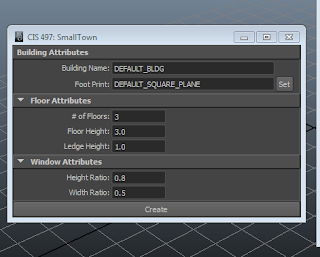Most of this week was spent on looking through sample scripts to see what command patterns other people use to generate building details. One thing I've realized is that although I'm fairly comfortable with MEL and python commands in Maya at this point, I still lack a lot of the experience that comes from long-term use of the languages. The most difficult part for me is knowing what commands I should use for a particular task. For example, the code I had before the alpha review had attempted to move the pivot of a model by using the move command in MEL. Now I know the the proper way to go about it is to use the xform command instead, since there is a scalePivot flag specifically for this operation. The python function I wrote for this looks like :
def movePivotToBottom(obj):
piv = cmds.xform(obj, q=1, ws=1, scalePivot=1)
newY = cmds.getAttr(obj + '.boundingBoxMinY')
piv[1] = newY
cmds.xform(obj, ws=1, scalePivot = piv)
I've written a few helper functions like this one that have been helping me understand the maya commands better. Something else that confused me for a while is the difference between, say cmds.scale(...) and cmds.setAttr(... + '.scale'). I've tried running both of them, and from what I can tell they both do the same thing. I just haven't figured out circumstances under which each command is advantageous.
Another thing I've realized is that there are MEL commands that aren't found in the online documentation at all. After a frustrating few hours, I found out from a forum that these are either run time commands, or procs that come with maya. To check, you can run whatIs
, and Maya would either tell you it's a run time command, or give you the path to the file containing the proc. At first I was worried that I wouldn't able to use certain commands/procs in python, but the maya.mel.eval command saved the day.
I'm almost done writing the function that adds columns to the base of the building. One problem I'm trying to fix right now is that the column-generation code relies on the subdivision of the footprint mesh, and my building-body mesh runs on the assumption that the footprint doesn't have any subdivisions. I'm planning on just making a copy of the subdivision-less footprint, adding subdivisions, and deleting it after the columns are generated. The only remaining problem is to make sure the columns are never intersecting with the building body, which I hope to solve by tomorrow. As I become more familiar with what I like to call "design patterns" for creating building assets, I hope to speed up my process and have images ready by the next update. Until then, stay tuned!














